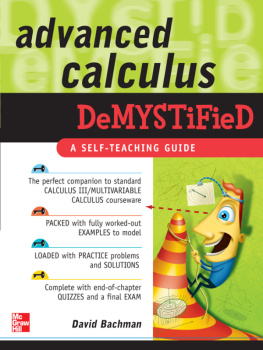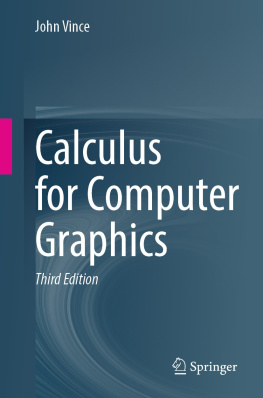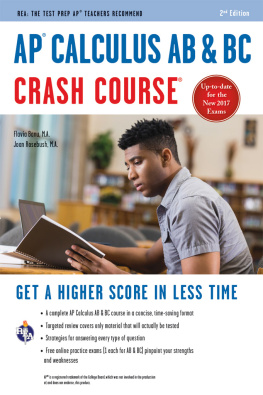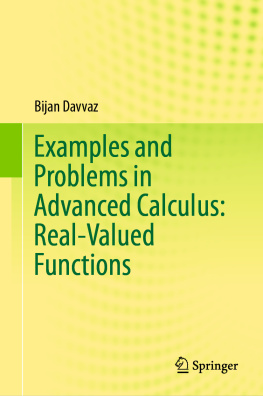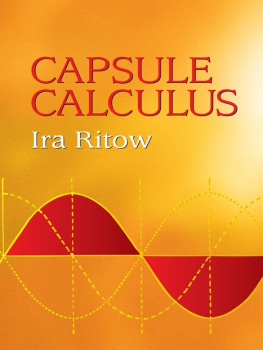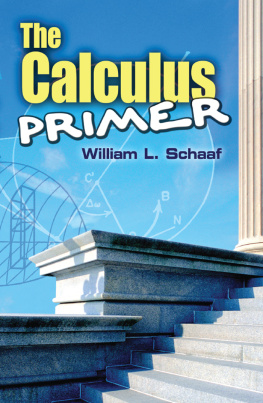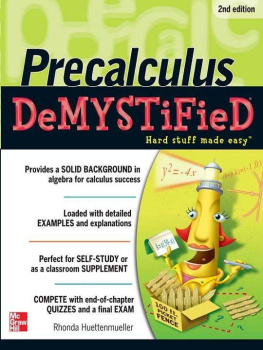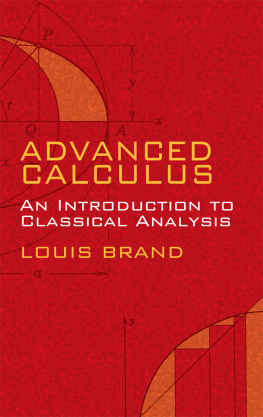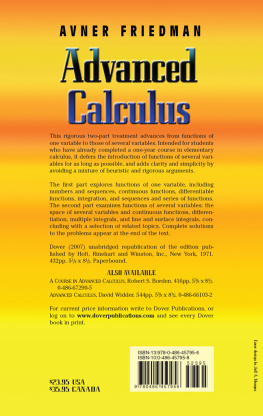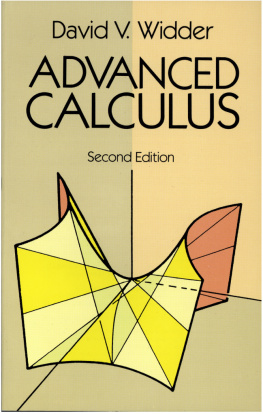Library of Congress Cataloging-in-Publication Data
Bachman, David.
Advanced calculus demystified / David Bachman.
p. cm. (Demystified series)
Includes index.
1. Calculus. I. Title.
QA303.2.B23 2007
515dc22
Advanced Calculus Demystified
Copyright 2007 by The McGraw-Hill Companies. All rights reserved. Except as permitted under the Copyright Act of 1976, no part of this publication may be reproduced or distributed in any form or by any means, or stored in a database or retrieval system, without the prior written permission of publisher.
ISBN: 978-0-07-151109-4
MHID: 0-07-151109-1
The material in this eBook also appears in the print version of this title: ISBN 978-0-07-148121-2, MHID 0-07-148121-4.
All trademarks are trademarks of their respective owners. Rather than put a trademark symbol after every occurrence of a trademarked name, we use names in an editorial fashion only, and to the benefit of the trademark owner, with no intention of infringement of the trademark. Where such designations appear in this book, they have been printed with initial caps.
McGraw-Hill eBooks are available at special quantity discounts to use as premiums and sales promotions, or for use in corporate training programs. To contact a representative please e-mail us at .
Sponsoring Editor
Judy Bass
Editorial Supervisor
Janet Walden
Project Manager
Gita Raman
Technical Editor
Steven Krantz
Copy Editor
Surendra Nath Shivam
Proofreader
Yumnam Ojen
Indexer
Valerie Perry
Production Supervisor
Jean Bodeaux
Composition
International Typesetting and Composition
Illustration
International Typesetting and Composition
Art Director, Cover
Jeff Weeks
Cover Illustration
Lance Lekander
Information has been obtained by McGraw-Hill from sources believed to be reliable. However, because of the possibility of human or mechanical error by our sources, McGraw-Hill, or others, McGraw-Hill does not guarantee the accuracy, adequacy, or completeness of any information and is not responsible for any errors or omissions or the results obtained from the use of such information.
TERMS OF USE
This is a copyrighted work and The McGraw-Hill Companies, Inc. (McGraw-Hill) and its licensors reserve all rights in and to the work. Use of this work is subject to these terms. Except as permitted under the Copyright Act of 1976 and the right to store and retrieve one copy of the work, you may not decompile, disassemble, reverse engineer, reproduce, modify, create derivative works based upon, transmit, distribute, disseminate, sell, publish or sublicense the work or any part of it without McGraw-Hills prior consent. You may use the work for your own noncommercial and personal use; any other use of the work is strictly prohibited. Your right to use the work may be terminated if you fail to comply with these terms.
THE WORK IS PROVIDED AS IS. McGRAW-HILL AND ITS LICENSORS MAKE NO GUARANTEES OR WARRANTIES AS TO THE ACCURACY, ADEQUACY OR COMPLETENESS OF OR RESULTS TO BE OBTAINED FROM USING THE WORK, INCLUDING ANY INFORMATION THAT CAN BE ACCESSED THROUGH THE WORK VIA HYPERLINK OR OTHERWISE, AND EXPRESSLY DISCLAIM ANY WARRANTY, EXPRESS OR IMPLIED, INCLUDING BUT NOT LIMITED TO IMPLIED WARRANTIES OF MERCHANTABILITY OR FITNESS FOR A PARTICULAR PURPOSE. McGraw-Hill and its licensors do not warrant or guarantee that the functions contained in the work will meet your requirements or that its operation will be uninterrupted or error free. Neither McGraw-Hill nor its licensors shall be liable to you or anyone else for any inaccuracy, error or omission, regardless of cause, in the work or for any damages resulting therefrom. McGraw-Hill has no responsibility for the content of any information accessed through the work. Under no circumstances shall McGraw-Hill and/or its licensors be liable for any indirect, incidental, special, punitive, consequential or similar damages that result from the use of or inability to use the work, even if any of them has been advised of the possibility of such damages. This limitation of liability shall apply to any claim or cause whatsoever whether such claim or cause arises in contract, tort or otherwise.
PREFACE
In the first year of calculus we study limits, derivatives, and integrals of functions with a single input, and a single output. The transition to advanced calculus is made when we generalize the notion of function to something which may have multiple inputs and multiple outputs. In this more general context limits, derivatives, and integrals take on new meanings and have new geometric interpretations. For example, in first-year calculus the derivative represents the slope of a tangent line at a specified point. When dealing with functions of multiple variables there may be many tangent lines at a point, so there will be many possible ways to differentiate.
The emphasis of this book is on developing enough familiarity with the material to solve difficult problems. Rigorous proofs are kept to a minimum. I have included numerous detailed examples so that you may see how the concepts really work. All exercises have detailed solutions that you can find at the end of the book. I regard these exercises, along with their solutions, to be an integral part of the material.
The present work is suitable for use as a stand-alone text, or as a companion to any standard book on the topic. This material is usually covered as part of a standard calculus sequence, coming just after the first full year. Names of college classes that cover this material vary greatly. Possibilities include advanced calculus, multivariable calculus, and vector calculus. At schools with semesters the class may be called Calculus III. At quarter schools it may be Calculus IV.
The best way to use this book is to read the material in each section and then try the exercises. If there is any exercise you dont get, make sure you study the solution carefully. At the end of each chapter you will find a quiz to test your understanding. These short quizzes are written to be similar to one that you may encounter in a classroom, and are intended to take 2030 minutes. They are not meant to test every idea presented in the chapter. The best way to use them is to study the chapter until you feel confident that you can handle anything that may be asked, and then try the quiz. You should have a good idea of how you did on it after looking at the answers. At the end of the text there is a final exam similar to one which you would find at the conclusion of a college class. It should take about two hours to complete. Use it as you do the quizzes. Study all of the material in the book until you feel confident, and then try it.

